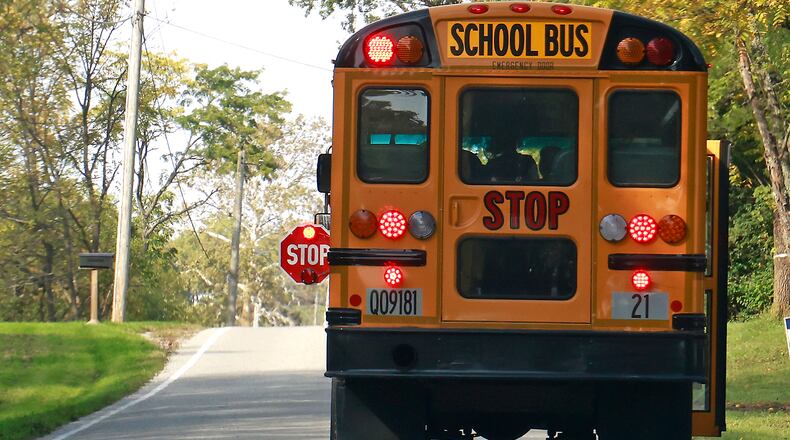“If another motorist fails to stop when a bus’ red light and stop sign is out or activated, the camera records that incident and the bus driver pushes a button that flags the time,” said Clark-Shawnee Superintendent Brian Kuhn, adding that schools then give the clip to the Ohio State Highway Patrol, who uses the footage to decide if they will issue a citation or not.
Before stopping to pick up or drop off students, school buses show yellow warning lights that signify the bus is about to stop. Once stopped, they show red flashing lights and a stop sign. Motorists who approach a stopped bus from either direction are required to stop at least 10 feet from the bus. When a road is divided into four or more lanes, only traffic driving the same direction as the bus must stop.
Kuhn said previously, bus drivers would try to remember the plate number and description of the driver to “the best of their ability” and fill out a report.
Now the school district has 15 buses that have the new cameras, but it still has some that are older. Kuhn said they added these cameras to some of the older buses, but it now comes included in the new buses’ camera systems.
Credit: Bill Lackey
Credit: Bill Lackey
Kuhn said he feels the new camera system is “more successful because it’s a bigger deterrent.”
“We see a lot of this on roads with two lanes. People coming opposite of the bus don’t know what to do. When in doubt, and there’s no physical median, stop. Or if you’re not sure, stop,” he said. Kuhn said there’s been a problem recently with people passing a bus on Selma Pike near the intersection at Sunset near Crossgate apartments.
A couple of years ago, Clark-Shawnee also upgraded its radio system to digital because a bus network allows for better reception. Last fall they started using a bus routing software system that allows parents to track buses in real time, to get drop-off and pick-up times through an app.
“We want our students on our buses to be safe. School buses are easy to be seen but it’s important to remember those red lights mean stop.
Other schools that have similar technology on their buses are Graham, Greenon and Southeastern local schools.
Graham installed cameras on six out of 16 of the buses so far for inside, and have “stop arm area cameras” to capture video of passing cars, said Director of Operations Don Burley. If this happens, the bus driver documents the time and watches the video to see if it recorded the violation, and if so, they turn it in to the state Highway Patrol. He said: “We have had many times when a vehicle has run through our red stop lights and were unable to report the details of a license plate number.”
Greenon has inside and outside cameras on its 18 buses that they use daily, said Director of Transportation Cindy Sandlin. Bus drivers with outside cameras need to get a detailed description of the drivers, but 95% of the time they catch a “very good picture” of the license plate, color, make and model of the vehicles. They have also upgraded their radios and added GPS to track the buses, and recently applied for a grant to add better GPS and tablets to the buses.
Southeastern has cameras on each of their eight buses, including one that records video of passing vehicles, said Director of Operations PJ Bertemes, adding it has been used a handful of times in the last five years. He said the bus driver lets the transportation director know a vehicle passed during a stop, they then pull the video from the bus to identify the vehicle/license plate number and contact the local police department.
Schools that don’t have this exact bus technology but still have and use cameras include Springfield City, Northeastern, Northwestern and Triad local schools.
Springfield has new cameras on buses that capture the driver’s point of view, but not the side cameras or technology related to helping to detect license plates.
“If the bus driver pushes the ‘event’ button, it will allow transportation staff to go directly to that time on the recording,” said communications specialist Jenna Leinasars. “However, that video is only picked up by the front camera; the buses do not have exterior cameras that operate in this way.”
Northeastern has a two-point camera system inside of the buses with one pointing down the aisle and the other at the door. The district relies on the “vigilance and experience” of the drivers to identify and report any violations.
“While we recognize the potential benefits (this) technology could provide, the cost of implementing such systems can be a significant challenge for our district,” said Superintendent Jack Fisher. “As responsible stewards of our resources, we must strike a balance between exploring innovative solutions and maintaining our commitment to providing high-quality education and services for our students.”
Northwestern has five cameras on their 19 buses, with four covering the student seats and one facing on-coming traffic.
“We use the camera systems to the best of our ability with assistance from the drivers/aides’ own eyes for capturing vehicle, plate and driver information, needed to file a report,” said Transportation Director Johanna Brents. “However, due to new state laws no longer requiring the use of a front license plate on most vehicles, our front facing camera systems are unable to do much when we are passed from the front.”
Triad has cameras on the sides of most of their buses to use in case someone runs the bus lights or stop sign, said Superintendent Vickie Maruniak. They have caught people from their current cameras and turn the video over to the School Resource Officer to handle from there.
About the Author


